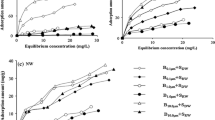Abstract
Reuse of reclaimed water for the eco-environmental water has become an effective measure to resolve the urban water crisis. However, it still contains large amounts of contaminants which may significantly affect the aquatic ecosystems. Biofilm attached on the surface of multiple matrixes in rivers and lakes is one of the indicators for describing the health of aquatic ecosystem. In this article, we chose eight rivers and lakes as the sampling locations, including three kinds of reclaimed water with different treatment processes and natural water. The morphology, structure and component characteristics of biofilms attached on the surface of aquatic plants and gravels in eight water bodies were evaluated. The results showed that the biofilm on the matrix surface were typical porous media with basic skeleton composed of inorganic particles, microorganisms and algae. The pores were filled with the viscous extracellular polymeric substances (EPS) secreted by microorganisms. The biofilms contained calcite, quartz, illite, alkali feldspar, dolomite, clinochlore, goethite and inorganic salt, and approximately 50 % of these compositions are calcite and quartz. The concentration of EPS was 20.78–500.44 μg/mL, and that of the gravel biofilms was less than that in aquatic plants by 18.1–75.3 %. In these three reclaimed waters, 4–7 kinds of PLFA (phospholipid fatty acid) were detected in aquatic plants biofilms, more than one or two kinds than in gravel biofilms. And the dominant PLFA were i15:0 and 18:0, the total contents of which were, respectively, 74.4, 62.9 and 85.9 % in the three kinds of reclaimed water. All biofilm samples contain major microorganisms such as Pseudomonas, Acinetobacter and Comamonas. This study is aimed to provide some support for assessing the health of river–lake ecosystem with biofilm indicator.








Similar content being viewed by others
References
Liang MC et al (2013) Structural and fractal characteristics of biofilm attached on the surfaces of aquatic plants and gravels in the rivers and lakes reusing reclaimed wastewater. Environ Earth Sci. 70(5):2319–2333
Baty AM (1996) Adhesion of biofilms to insert surfaces: a molecular level approach directed at the marine environment. Biofouling 10(1–3):111–121
Costerton JW, Stewat PS, Greenberg EP (1999) Bacterial biofilms: a common cause of persistent infections. Science 284:1318
Dong D, Yang F, Li Y, Hua X, Lǚ X, Zhang J (2005) Adsorption of Pb, Cd to Fe, Mn oxides in natural freshwater surface coatings developed in different seasons. J Environ Sci 17(1):30–36
Dong DM et al (2006) Comparison of components and distribution of heavy metals in sediments, suspended particulate matter and surface coatings in natural waters. Chin J Geochem 25(1):200–201
Fdz-Polanco F, Villaverde S, Garcia PA (1996) Nitrite accumulation in submerged biofilters-combined effects. Water Sci Technol 34(3–4):371–378
Felsenstein J (1985) Confidence limits on phylogenies: an approach using the bootstrap. Evolution 39:783–791
Frølund B et al (1996) Extraction of extracellular polymers from activated sludge using a cation exchange resin. Water Res 30(8):1749–1758
Gan YP, Bai Y (2010) The advanced treatment and recycling technologies in sewage treatment plant. China Architecture & Building Press 7(1):198–314
Hong L, Herbert HP (2002) Extraction of extracurricular polymeric substances (EPS) of Sludges. J Biotechnol 95(3):249–256
Hu X et al. (2005) Chemical components and heavy metals in sludge from wastewater treatment plant. J Agro Environ Sci 24(2):387–391
Huang JP, Wu LY (2008) Standard implementation guide for urban sewage recycling. Standards Press of China, Beijing
Juanico M, Friedler E (1999) Wastewater reuse for river recover in Serni and Israel. Water Sci Technol 40:43–50
Kumar S, Tamura K, Nei M (2004) MEGA3: integrated software for molecular evolutionary genetics analysis and sequence alignment. Brief Bioinf 5:150–163
Li JY, Zuo H, Luan ZK, Zhu BX et al (2002) Effects of substrate conditions on compositions of extracellular polymeric substances in biofilms. Environ Chem 21(6):546–551
Lowry OH, Rosebrough NJ, Farr AL (1951) Protein measurement with the Folin phenol reagent. J Biol Chem 193(1):265–275
Nocker A et al (2007) Response of estuarine biofilm microbial community development to changes in dissolved oxygen and nutrient concentrations. Microb Ecol 54(3):532–542
Pennanen T et al (1999) Structure of the microbial communities in coniferous forest soils in relation to site fertility and stand development stage. Microb Ecol 2:168–179
Percival SL (1998) Biofilm development on stainless steel. Water Res 32(1):243–253
Picioreanu C, Loodrecht MCM, Heijinen JJ (2001) Two-dimensional model of biofilm detachment caused by internal stress from liquid flow. Biotechnol Bioeng 72:205–218
Qin SY (2008) Study on morphology and biodiversity of biofilm of river oder. PhD thesis, Harbin Institute of Technology
Qiu LP, Ma J (2005) Characters of biofilm and its microorganism population in biological aerobic filter. China Environ Sci 25(2):214–217
Reichert P, Wanner O (1997) Movement of solids in biofilms: significance of liquid phase transport. Water Sci Technol 36(1):321–328
Sandhu A, Halverson LJ, Beattie GA (2007) Bacterial degradation of airborne phenol in the phyllosphere. Environ Microbiol 9:383–392
Sergi S, Helena G, Anna R (2002) The effect biological factors on the efficiency of river biofilms in improving water quality. Hydrobiologia 469:149–156
Vestal JR, White DC (1989) Lipidalysis in microbial ecology: quantitative approaches to the study of microbial communities. Bioscience 39:535–541
Wang WJ et al (2002) Element contents of biofilm and suspended particulate in natural aquatic ecosystem. Chin J Appl Ecol 13(8):1001
Wei F (2002) Water and exhausted water monitoring analysis method. China Environmental Science Press, Beijing. ISBN 7-80163-400-4
Xing FD, Ren NQ, Gong ML (2005) Application of PCR-DGGE to resolve microbial diversity in bio-hydrogen producing reactor. Environ Sci 26(02):172–176
Yu YX, Wu GQ, Meng XT (1990) Environmental engineering microbiology manual. Chinese Environmental Science Press, Beijing
Author information
Authors and Affiliations
Corresponding author
Rights and permissions
About this article
Cite this article
Tianzhi, W., Yunkai, L., Mingchao, L. et al. Biofilms on the surface of gravels and aquatic plants in rivers and lakes with reusing reclaimed water. Environ Earth Sci 72, 743–755 (2014). https://doi.org/10.1007/s12665-013-2998-3
Received:
Accepted:
Published:
Issue Date:
DOI: https://doi.org/10.1007/s12665-013-2998-3




